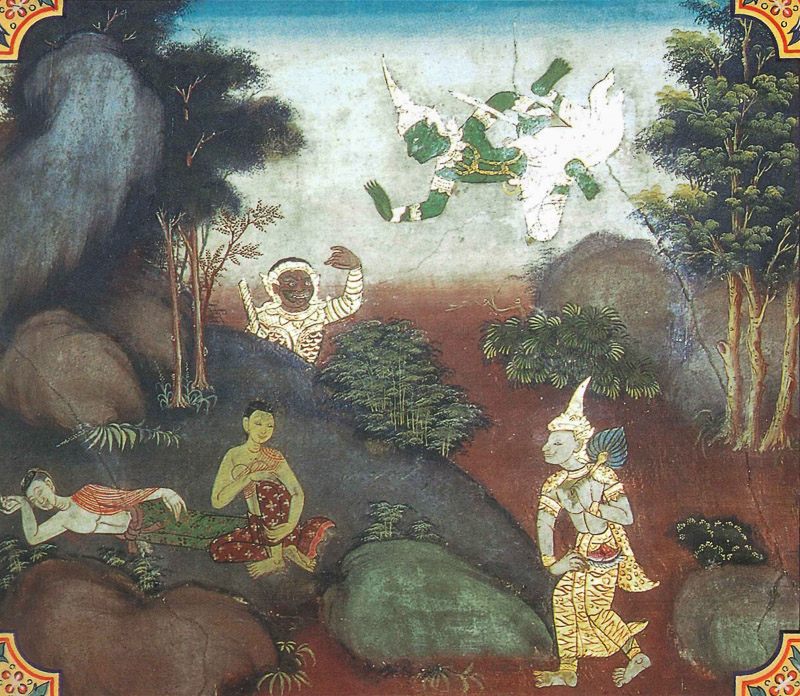
The Bodhisatta was once a king. His son, who served as viceroy, caught leprosy. Because of his suffering, he decided to go live alone as an ascetic in the Himalayas. His beautiful and gifted wife, the chief princess, was so loyal she insisted on going with him. They lived in a leaf hut in the forest, and she was fully dedicated to her husband’s care; cleaning his sores, gathering food, bathing him, and everything else.
One day, while out collecting wild fruit, the princess bathed herself in a mountain cave, and the whole forest lit up from her radiance. A goblin saw her and fell in love. He came and seized her, giving her the choice to be his wife or his meal. Her mind turned not to her own demise, but to her husband, who would die quickly if left alone. Her exceptional virtue caused the throne of Indra, king of the gods, to become warm. And when he divined the cause, he rushed down from heaven and stood above the goblin, telling him that she was a perfect woman, and if he did not set her free, his skull would be smashed into seven pieces. The goblin complied. Indra knew that the goblin would try to seize her again another time, so he bound him in chains and banished him to a faraway mountain range. Her safety assured, the princess returned home by the light of the moon.
The prince was angry about his wife’s late arrival. She apologized and explained what had happened, but he doubted her story: “Women rarely tell the truth and there are many foresters, ascetics, and magicians living around here, so who knows what you were doing.” To prove her virtue, the princess spoke an act of truth (a solemn declaration of one’s supreme virtue followed by a request for some miraculous result) that would heal his leprosy. She declared her love and fidelity and poured water over her husband; and it washed his sores away like acid rinsing the tarnish off copper.
Now healed, the prince was able to return home. The Bodhisatta was so happy to have his son back that he gave him the throne and ordered that the princess should be the chief queen. The Bodhisatta then took up an ascetic’s life in the royal park. The new king was completely ungrateful for everything the queen had done for him over the years and he ignored her, spending all his time with other women. The queen grew thin and pale out of jealousy and eventually went to see the Bodhisatta, hoping he could help with her grief. The Bodhisatta summoned his son and rebuked his terrible behavior, telling him to treat his wife the way she deserved. Shamed, he apologized and promised to do whatever she wanted. From then on, they lived a happy life together, giving charity and doing good works.
In the Lifetime of the Buddha
The king and queen of the past were earlier births of King Pasenadi, a righteous ruler and devoted supporter of the Buddha, and Queen Mallika, his exceptionally wise chief queen. Before she married him, Mallika was just the daughter of a garland-maker. One day she and some friends were walking to a flower garden when she saw the Buddha coming into the city. She gave him three portions of sour gruel that she had packed to eat later, and after he received it, the Buddha smiled. Ananda, one of the Buddha’s top disciples, asked the Buddha why he smiled, and he answered that, thanks to her modest offering, she would become chief queen by the end of the day.
Mallika continued on to the flower garden, and soon after, the king heard her singing. Struck by her beauty, he asked if she was married. Finding that she wasn’t, he took her back to his palace and made her his queen. They were a happy, loving couple, and everyone in the city knew she was a devoted wife.
When the Buddha heard some of his disciples discussing her devotion, he told them this story so they knew that she had also been a devoted wife in the past.
